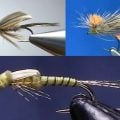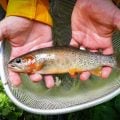How to Tie the NZ Trico
Producer: tightlinevideo
Summertime in the Northeastern United States can be a tough time for trout fishing. Even if flows are good and water temperatures are well below 70 degrees, trout simply aren’t as active as when rivers and streams are running cooler. There are a couple of exceptions of which the trico hatch is certainly one. On many stretches of water, the most obvious instances of trout taking tricos off the surface occur just after first light. Fast, dimply rises are the dead giveaway as are the diminutive tricos, either duns or spinners or both, barely visible on the water’s surface. Trout can get very particular at this time, often preferring spinners over duns, or vice versa, and even targeting male or female tricos. But, when it’s on, it can be really on and, yes, remarkably frustrating.
This relatively simple pattern, I call the NZ Trico, is one I often use to imitate both duns and spinners floating on the water’s surface. It’s very similar to other trico dries, except that it has a New Zealand wool wing.
The fly starts with a size 20 Fulling Mill 5050 dry fly hook, but tying down to even a size 24 isn’t too difficult. After getting the hook firmly secured in the jaws of your tying vise, load a bobbin with some small-diameter black thread, here, Veevus 16/0. The idea is to keep bulk to a minimum.
Begin with an overly long tag, say 2-3” then get the thread started on the hook shank, leaving some space behind the back edge of the hook eye. After a few securing wraps rearward, snip off the overly long tag and keep it within easy reach on your tying bench.
Microfibbets, or Mayfly Tails, in white or light gray are used for the tail of the fly. I do prefer the ones that have been treated with Water Shed, which helps the fly to float longer. Separate three fibers from the clump. This may well be the hardest part of your day. After pulling the fibers free, orient them so the tapered tips are even and point to the rear of the fly. Measure to form tails 1 1/2 to 2 hook lengths long. Use a pinch wrap to begin securing the three fibers to the top of the hook shank. Pull slightly up and toward you on the fibers as you wrap, so they don’t get pushed down either side of the shank. Pull the tails up and use your thumbnail to lightly crease them at the rearmost tie-down point. This should separate them, about like this. Lift the butt ends of the fibers up to vertical and snip them off nice and close.
Retrieve that extra-long thread tag you cut off earlier and work its midpoint into the bend of the hook, behind your tying thread. Pull up on the thread so the two legs go up between the tails, with the center tail between the strands. Take a few wraps of tying thread to lightly anchor the folded tag then gently pull on the tag to seat it and further splay the three tails. With this done, take forward thread wraps and snip the excess tag off close. The fly should now look something like this. Continue taking forward thread wraps to cover up the butt ends of the tailing material then leave your thread about two eye-lengths behind the back edge of the hook eye.
I’ve been using New Zealand wool strike indicators for years and always have the material on hand. It’s available nearly everywhere and the indicators it produces work exceptionally well. But here, I’m just going to take a small clump of the white lanolin-rich wool from its container. Pull the clump apart several times to help align the fibers. In the textile industry, this is called carding. You should end up with a thin elongated clump. Lay the midpoint of the clump against the near side of the hook and begin taking tight wraps of tying thread to secure it, while keeping hold of the rearward-pointing portion. You can then lift the material up and snip it off close at a shallow angle.
Pull up and back on the forward-pointing material and take a few jam wraps in front of it to help prop it up. Twist the material clockwise, as if you’re looking down on it, then fold it over to form a short furled loop or post. Take tight wraps of tying thread at its base to anchor the forward-pointing material, then lift that material up and carefully snip it off close and at an angle behind the hook eye. Sometimes you jostle the tails while doing this but they should be easily brought back into alignment. The fly should now look about like this.
I use just a little bit of black Super Fine dubbing to help clean things up at the base of the wing. You need only the smallest of wisps. Use the dubbing to create a super thin, 1” long noodle on your tying thread. Here, less is generally more. Start taking wraps with the noodle to cover up the exposed butt ends of the wool, hopefully ending with bare thread at the back edge of the hook eye. Reach for your whip finish tool and use it to do a 4 or 5 turn, back to front whip finish, seat the knot well and snip or cut your tying thread free.
Now the fun part—snip the top of the loop off. At this point you want to keep the wing fairly long. Spread the material out and, if necessary, give it a little trim to length. It should naturally spread out side to side, kind of like a comparadun wing.
Because this pattern is so small, I find it much easier to get a hold of it with plunger-style hackle pliers or hemostats when it comes time to tie it onto my leader. The leaders are usually long, 12 and even 14 feet, and end in 6 or 7x tippet. To me, anything else is too heavy for a fly this small. I also fish this fly solo, feeling that a larger indicator fly just messes with their drift too much. Yes, 6 and 7x tippet material can be difficult both to see and handle, but the plunger-style hackle pliers allow me to hold the fly steady without my fingers getting in the way, which, in turn, helps to feed the delicate tippet through the nearly microscopic hook eye.
With the tippet through the eye, I like to use a 3 or 4 turn Uni knot well up the tippet from the fly. This allows me to easily trim off the tag end before seating the knot against the hook eye. It’s important to lubricate both legs of the loop before pulling on the mono to seat the knot. Just make sure that it’s snugged up well against the hook eye before removing the fly from the hackle pliers.
Even with the lanolin-rich New Zealand wool, the fly will eventually begin to sink after several drifts. To get it floating again, use an amadou patch or a chamois to remove the excess water from the fly. I then like to brush on a dry desiccant, such as Frog’s Fanny, to remove any water that’s soaked in. After blowing the desiccant off, I’ll then work in a little liquid floatant, such as Loon’s Aquel. Getting it into the wing, body and tails helps a lot.
Once the fly is dried out and well dressed, the New Zealand wool wing, along with the splayed microfibbet tails, do a remarkable job of keeping the fly on the water’s surface.
How to Tie the Nuke Egg
How to Tie the Olive X-Caddis











